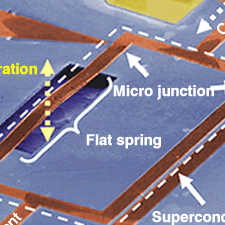Observation of one part in one hundred trillion meter mechanical vibration with a superconducting quantum interference device
- Toward the observation of quantum phenomena in macroscopic objects -

NTT Basic Research Laboratories have successfully observed a microscopic vibration of about 10 fm by using a micro machine structure (leaf spring) fabricated from a part of a superconducting quantum interference device (SQUID). This achievement demonstrates a new and promising method for the observation of quantum phenomena in a macroscopic object.
The behavior of atoms and electrons, which are the elemental components of all materials, is known to be controlled by quantum mechanics. If we are to examine how a macroscopic object behaves in the real world, we need a super-sensitive detection method for measuring the microscopic motion of a macroscopic object with the least disturbance. NTT Basic Research Laboratories have fabricated the novel device shown in Fig. 1 by using their original crystal growth technology. This device detects an extremely small vibration of 10 fm via the resistance change of a SQUID that is caused by the vibration of the leaf spring (Fig. 2).
This achievement was the result of a joint research project with Delft University of Technology in Holland, and will be published in the electronic edition of the UK science journal "Nature Physics" on August 31.
=> Nanostructure Technology Research Group

Fig. 1 Structure of a superconducting quantum interference device with a flat spring
First, we fabricate a superconducting quantum interference device with a rectangular loop (shown by the dashed lines in Fig. 1, superconducting circuit). Next, we remove a part of the substrate below the SQUID circuit with selective etching leaving a small leaf spring suspended in midair. The original technology for crystal growth developed by NTT Basic Research Laboratories is indispensable for fabricating this device. The leaf spring is 50 µm long, 4 µm wide and 0.5 µm thick.

Fig. 2 Principle for detecting one part in one hundred trillion meter mechanical vibrations
A SQUID, which is a well-known magnetic field detection device, detects the total magnetic field (magnetic flux) that runs through an area surrounded by a superconducting circuit. If the leaf spring vibrates while the magnetic field is applied from an oblique direction, the number of the magnetic fluxes that run through the superconducting circuit changes periodically. In this experiment, the residual thermal vibration at ultra-low temperatures below 1 Kelvin has been detected with a SQUID (Fig. 2b). The sensitivity of the device estimated from the experimental results is 10 fm in terms of the amplitude of the leaf spring (1/10000 of the size of an atom, similar to the size of a nucleus).










